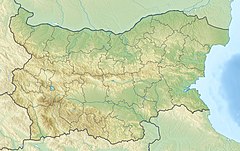Belogradchik Observatory
This article needs additional citations for verification. (February 2024) |
| Organization | Institute of Astronomy, BAS | ||||||
|---|---|---|---|---|---|---|---|
| Location | Belogradchik, Bulgaria | ||||||
| Coordinates | 43°37′22″N 22°40′30″E / 43.62278°N 22.67500°E | ||||||
| Altitude | 650 m (2,134 ft) | ||||||
| Established | 1961 / 1965 | ||||||
| Website | www | ||||||
| Telescopes | |||||||
| |||||||
| | |||||||
The Astronomical Observatory of Belogradchik or Belogradchik Observatory is an astronomical observatory[1] owned and operated by the Institute of Astronomy of the Bulgarian Academy of Sciences. It is located near the town of Belogradchik in northwestern Bulgaria, at the foot of the Western Balkan Mountains. The other observatory operated by the same institute is the Rozhen Observatory.
History
Built in 1961 by a group of astronomy enthusiasts led by high school physics teacher and later chief assistant professor in
Equipment
The observatory started out with a single 15 cm
Instrumentation
In 1973 the first Bulgarian single channel electro-
Observations
At first the observatory has been used for satellite astrometry (1960s-1970s). Between 1964 and 1974 more than 1000 Soviet satellites were observed and data sent to Mission Control Centre in Moscow for orbit corrections. Later, during the 1970s and 1980s, Photo-electric surveys of more than 200 catalogue double and multiple galaxies (1970s-1980s) were carried out. Holmberg effect was used to confirm or rule out physical and visual systems (binaries and multiplets). Notable results were included in "A General Catalogue of Photoelectric Magnitudes and Colours in the UBV System of 3578 Galaxies, Brighter than the 16-th V Magnitude (1936-1982)" by G. Longo, Antoinette de Vaucouleurs and H.G. Corwin (1983) (see also
See also
- List of astronomical observatories
- Category:Astronomical observatories by country
- Category:Astronomical observatories in Bulgaria
References
- ^ "Astronomical Observatory". Fodor's. Retrieved 2024-02-05.

